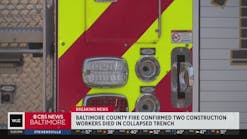Portable vacuum excavators have been a regular sight on job sites for years. These unique units were originally used to clean septic tanks and car wash pits and to remove slurry from horizontal directional drilling projects. Now contractors are discovering that these machines have a wide range of uses on the job site, from potholing for utilities to cleaning valve boxes. Vacuum excavators are self-contained units that use pressurized air or water to displace soil and create a dry or wet spoil. The displaced dry or wet spoil is removed from the area through a hose using high-velocity suction and stored in a holding tank on the vacuum. Vacuum excavators can be mounted to a trailer or the back of a truck and range in size from 100 to 1,200 gallons of capacity. Since vacuum excavators use low-pressure air or water to remove spoil, they are perfect for potholing or identifying existing utilities during underground construction projects. "Damaging existing utilities can be costly in terms of project downtime and potential contractor fines," says Dave Gasmovic, president of McLaughlin Boring Systems in Greenville, S.C. "The low-pressure water and air will not damage existing utilities like a backhoe, compact excavator or shovel. In fact, the air and water move around the existing utilities, giving the operator a clear view." Operators can select the amount of air or water pressure appropriate for the utility. A lower pressure of 1,500 psi should be used for gas and fiber lines in order to not damage the line coating. A higher pressure can be used for water lines. While locators are becoming more accurate, it's still important to see exactly where the line or pipe is located. Contractors are not allowed to dig in the safe zone, which may be from 18 inches up to 3 feet from either side of the marked line. The required distance varies by state. Contractors are only allowed to dig by hand or use a non-destructive method like vacuum excavators in the safe zone. Using a vacuum excavator instead of a shovel has advantages. A shovel against a water pipe is non-destructive, but on a fiber optic line a shovel can be as destructive as a backhoe, especially in hard ground conditions. "A lot of cable has been installed using horizontal directional drills (HDD) rather than trenchers, so you don't have the old-fashioned ditch line like in the past," says Gasmovic. When lines are installed using a trencher or backhoe, a lighter material like sand is placed around the line. As a contractor digs, the ground gets softer. This indicates the line is in close proximity. Lines installed using HDD don't disturb the ground or leave a ditch line, so the ground is the same hardness and it is difficult to know if you are getting close to the line or cable. Since the ground may be hard, you can easily cut a cable line with a shovel. Using a vacuum with air or water at a non-damaging pressure will safely expose the line. Vacuum excavators come in all sizes and options, so it's important to select a unit that will best fit your intended use. Water-based units typically dig faster through a wide variety of spoil types and reduce the volume of the excavated material. These units move more displaced wet spoil into a holding tank than an air system. However, the displaced spoil is wet and cannot be returned to the site immediately without drying. While spoil from air systems can be directly returned to the site, these systems do not cut as well in hard ground conditions, such as clay. "I encourage contractors to look for a unit with a good-quality vacuum blower, the heart of the vacuum," say Gasmovic. "They should also select a tank that has the capacity to hold a half-day's or day's worth of spoil. This will reduce the number of trips you need to make to dump the holding tank." If you are working in areas with cobble rock, then a unit with a 4-inch hose and 1,025-cfm blower unit will be more productive. Cobble soils will require a larger blower to effectively remove the spoil. The larger diameter of 4-inch hose will help reduce the potential for clogging. In areas without rocks, a 575-cfm system and 3-inch hose will suffice. The blower size also affects the amount of engine power required — a larger blower will increase the cost of the unit. Gasmovic recommends that contractors pay special attention to the filtration system and select a system that will filter the spoil and avoid clogging. Finally, be sure to select a strong trailer frame that will support the weight of the unit and a full tank of spoil. There are a number of options available: controls that allow the contractor to reverse the flow of the vacuum to blow the spoil back into the hole; booms that support the weight of the hose, placing less effort on the operator; combo units that include a jetter to clean sewers and remove the resulting trash; and automatic tank clean-out systems and auxiliary hydraulic systems that allow the contractor to run a concrete saw or breaker off the unit. Taking the extra steps to pothole may seem like an added expense or more time, but Gasmovic stresses that safety is important. "Hitting a gas line with a backhoe, trencher or HDD could be catastrophic. A water line hit could put a hospital out of business," says Gasmovic. "The cost of shutting down a project for a day is sure to exceed the cost for a $3,000 locator and a little extra time."




